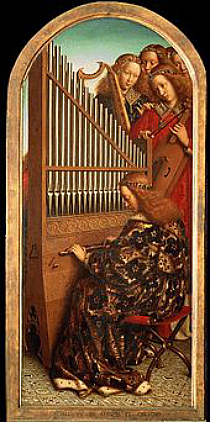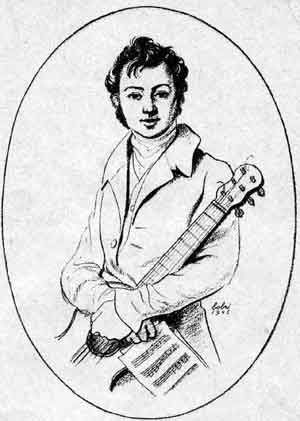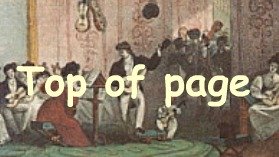The History of
Tablature Notation
The form of music notation known as tablature (or tabulature, or tab for short) is distinctive in that it indicates instrument fingering rather than musical pitches.

Music for the medieval
organ was notated in tablature
Painting by Jan van Eyck
This notation is common for the notating of music for fretted stringed instruments such as the lute, vihuela, or guitar. Other instruments that have used tablature include free reed aerophones such as the harmonica, organ, and the ocarina.
It was widely used in Renaissance and Baroque periods, and today is often used for popular musical genres such as rock 'n roll, folk, bluegrass and blues.
Standard music notation is generally referred to as "staff notation" or just "notation".
Etymology
The word tablature originates from the Latin word "tabulatura". It was first used in Europe around 1300 when it referred to the notating of organ music.Concepts
Standard notation represents the rythm and duration of each note, as well as its pitch relative to the scale based on a twelve tone division of the octave. Tablature is instead operationally based thus indicating where and when a finger should be placed to generate a note. Tablature for plucked strings features a diagrammatic representation of the strings and frets of the instrument.While tablature is a form of music notation that is easier to learn by the novice musician, it does have some significant deficiencies when compared to standard notation.
performed by
Oh Seung Kook
Due to these deficiencies an attempt was made to transfer from lute tablature to standard notation. To understand the motivation for this change we can read the writings of a le Sieur Perrine, who in 1679 wrote a lute theory book Livre de Musique pour le Lut. In the book he says :
. . . those who would play this noble instrument . . . could do so with many different types of other instruments, something which has been done until now only irregularly because of the difficulty one always found to make a just rapport between lute tablature and standard pitch notation, and between pitch notation and tablature. But when everyone would speak the same language, there will no longer be any confusion .
By 1830 the use of a single staff had been established for the notation of guitar music. This emulated the methods used in violin notation. Fernando Sor attempted to use a grand staff (piano staff) in his Fantaisie Op. 7.(11), but this was not successful.

Fernando attempted to use
the piano staff to notate guitar music
At around this time the renowned music historian Raphael Georg Kiesewetter wrote about the subject of lute and guitar notation in 1831 : his opinions appear in an article found in the Allgemeine Musikalische Zeitung where he stated :
So wherein lies then the need, or the necessity of using tablature? — Mr. Mauro Giuliani had shown the lutenists, how, on a very similarly constructed instrument, the guitar, one may understand how to set down [the fingers] on all the frets and thus dispense with tablature.
Other Notation :






